Signal Types
Japanese signals come in several forms. Main signals control moving trains. Call-on and shunting signals control train and locomotives within station areas for specific types of movements. And then there are a number of other, more specialized, types.
Signals are composed of a variety of indicators. Main signals are color-lamp signals with one or more related heads (each head is for a specific route, and they share a mast but subordinate ones are located at an offset below and to the side, not directly below the main head). Position-light signals are used for shunting signals, repeating signals, and some other specialized forms. And individual lunar (“white”) markers, alphanumeric displays or other methods are used as “signal appendixes” to qualify a main or shunting signal.
Signal lamp lenses for home, start and block signals must be a minimum of 100 mm and be spaced by a minimum of 200 mm (180 mm in tunnels). I’ve included more detail on this at the foot of the page.
All references to “the MLIT document” are to an English translation of Japanese regulations and standards applying to signals. See Technical Standard for Japanese Railway in the references section at the end of the Japanese Signaling page.
A Note on Shinkansen
The Shinkansen (bullet train) lines are dedicated rights-of-way not shared with other types of trains. They don’t even use the same gauge of rail as most Japanese lines. All Shinkansen are equipped with cab signals that are constantly updated, not simply updated when passing a signal location. Thus, in general, fixed signals don’t exist on Shinkansen lines. There are some exceptions, and these are collectively referred to as “wayside” signals in the MLIT document. These are placed at “stations and halts” where a train may need to enter and leave with non-functional cab signals. They appear to take the function of both a home signal and a combination starting/block signal, and can potentially display all of the aspects allowed for Main signals described below (although individual signals may be limited to a subset as with other main signals). Apparently wayside signals, probably of the small-size position-light type, can also be used as shunting signals (see below) at stations and depots.
Types of Main Signals: Home, Starting, and Block
There are three types of “Main Signal” (主信号機, shu shingōki): the Home Signal, the Starting Signal, and the Block Signal. All of these may also function as part of an Automatic Block Signal system (Japanese type). However, in a formal sense, track within a multi-track station is normally not considered to be a block, but a place between blocks. Simple stations with no additional station tracks may exist within a block without specialized signals. All Main signal heads use an oval surround, which distinguishes them from other types of signals.
Note: Japanese signal masts are often marked with signs bearing the first two Kanji characters from the signal name (thus “出発” appearing on a starting signal). In some cases this is simplified further, as seen in the starting signal photo below, where only the first Kanji appears, below the track number within the station).
Home Signal
A Home Signal (場内信号機 jōnai shingōki) is one that controls entrance into a station. It is typically set by the stationmaster (or staff under his control), and goes to “Stop” once passed by a train. If I’m reading the Japanese page right, this is an absolute signal (絶対信号機 zettai shingōki), and must not be passed if set to the “Stop” indication (except when authorized by a call-on signal), which agrees with the wikipedia entry. Normally a Home Signal is a three-indication Red/Yellow/Green signal, however two-indication Red/Yellow are used at terminal stations (where trains cannot run through the station at full speed). A Home signal will be marked with a block sign (orange triangle) bearing the kanji “場” (“place”).
In some cases the sign will be marked “二場” (two place), but the meaning is unclear. In one example this was combined with a block signal that allowed running through the station at speed, in another it was on a mid-platform signal.
A Home Signal must be located not less than 100 meters in advance of the thing for which it is a home signal (platform, etc) when trains operate at 100 kph or more. At lesser speeds it can be located more closely, down to a minimum distance of 40m for speeds below 65 kph.
Note that Japanese signaling practice is similar to European practice rather than North American, in that a home signal does not authorize travel into and past an interlocking (e.g., a station), but only provides authorization into it. A block signal, normally the specialized starting signal, is required to admit a train from the station into the next block.
Starting Signal
A Starting Signal (出発信号機 shuppatsu shingōki), like a home signal, is operated under a combination of human and automated control (and is thus called a “semi-automatic” signal). It clears trains to depart a station when the switches are lined to the correct exit track. Like a Home Signal it is typically a three-indicator signal, however it may be a two-indicator (Green/Red) signal on single-track, or a more complex signal when it is also acting as a block signal. When a two-aspect signal is used, it may be coupled with a passing signal (see below). A Starting signal will be marked with a sign bearing the kanji “出” (“out” or “exit”). It may also be marked with a station track number (as below) or a block sign (often with or on an orange triangle).
Starting signals are not required if there is only one track departing the station or if there is a switch but it is either locked or a spring-switch design (a block signal would likely exist to control entry to the next block). With multiple platforms on the same line, the starting signals would be at or near the platform and authorize trains to move out to the block signal, which could be within the station bounds.
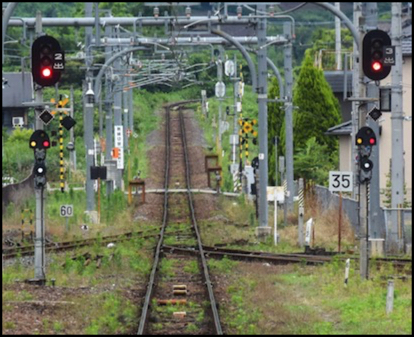
Starting Signals (with shunting and call-on signals) for tracks 2 & 3 (JR West Kamo Station, Kyoto, 2014)
Note: you can also see the back of the three-headed home signal to the right of the track above the yellow crossbuck.
Photographer: m-louis
Block Signal
A Block Signal (閉塞信号機 heisoku shingōki) is an automatic signal, controlled only by track conditions. It authorizes travel into the next block of track along a line between stations. Older block signals are numbered in decreasing order, with “1” being the last block signal before a station (but see the comment about ATOS below); beyond the station, numbering starts afresh. In some stations the platform will be divided in two sections, with a “block 0” signal before the second half. This is a significant difference from common North American practice, which typically identifies signals with an absolute number (often the nearest milepost).
English translations use the phrase Automatic Block Signaling (sometimes abbreviated ABS) to describe the system in use, but while this has some similarities with North American ABS it is not the same system. Also, British Signaling uses the same phrase to describe something very different that should not be confused with Japanese ABS.
Home or starting signals may also function as block signals, admitting trains into the next block.
Block signals may be permissive signals, and if so may be passed at reduced speed (typically under 15 kph, and operating in a manner allowing the train to stop short of obstructions), but only after the train has come to a halt and waited a set period (typically one minute).
Note: If I read this correctly, some Japanese lines operate (or operated) in a manner that allowed a train to pass a stop signal after waiting, and resume either normal or limited travel, without the “in a manner permitting the train to stop short of an obstruction” restriction. After several notable accidents some lines, including JR, adopted the more restrictive rule. On other lines, it appears that the signals are now being treated as absolute, requiring a train to stop and wait until the signal changes (or some other system is invoked by a dispatcher to explicitly pass the train).
Additionally, JR East operates many of its lines under the Automated Decentralized Transport Operations Control (ATOS) system, and on such lines block signals are numbered “serially”, and some do double duty as both Block and Home or Starting signals per wikipedia.
Cab Signal
A cab signal (車内信号機 Shanaishingōki) is on where the actual signal is inside the train, displayed on a special device or display. Cab signals eliminate the need for normal block, starting, and home signals if all trains are equipped for them, which is typical in Japan on lines that use them. All Shinkansen lines use cab signals, and the Yamanote line does as well. These are likely to become more common over time, and displace lineside signals elsewhere.
Subsidiary Signals
There are three types of subsidiary signals (従属信号機, jūzoku shingōki) that are used when visibility of an upcoming main signal is restricted, to give some form of advance notice (see also the Signal Appendix description for another kind of advance notice). All of these use specially-shaped surrounds that cannot be confused with that of a main signal head.
Distant Signal
Distant Signals (遠方信号機 enpō shingōki) are mainly used on single-track lines, are considered subsidiary to a home signal, and provide a short block prior to a station. Unlike a “repeater” they display a different aspect from the home signal. Distant signals are treated differently from ordinary signals (the machine-translated text of the Japanese wikipedia page isn’t clear, but I think a “stop” is interpreted as “stop at the next signal” rather than “stop here”), and are marked with a square surround on the head, rather than an oval one. Distant signals may display Proceed (G, displayed only if the home signal displays proceed also), Reduced Speed (Y-over-G, displayed when the home signal indicates reduced speed or caution), or Caution (Y, displayed when the home signal is at Stop). A Distant signal will be marked with a block sign (orange triangle) bearing the kanji “遠” (“far” or “distant”).
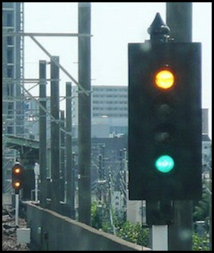
Home Signal at Restricted Speed (Y over Y, left) and distant at Reduced Speed (Y over G, right), Hachiman station (2008)
Location: between Hachiman and Sukenobu stations on the Enshū Railway Line
Photographer: PekePON
I have also seen one reference to the use of a distant subordinate signal, which wasn’t a full signal head, but simply a light below and offset from the signal head, which would be lit to indicate that a diverging route would be indicated at the next signal. This was apparently on the Keihin Electric Express Railway (aka Keikyū), although that wasn’t definite. This may simply be a Preliminary Route Indicator (see below).
Japanese Wikipedia cites the square surround as indicating a “far-pass signal” (遠方・通過信号 Enpō tsūka shingō). I think that’s a reference to both distant (Far) and Passing (Pass) signals using such surrounds.
Passing Signal
A Passing Signal (通過信号機 tsūka shingōki),assuming I’m reading Japanese wikipedia correctly, is placed below a Home signal when the Starting signal can’t be seen by an approaching train, and it reflects (but does not match) the indication of the staring signal. The MLIT document seems to agree with this interpretation, although it is less explicit. This allows an approaching train that doesn’t stop at this station to know if it has to begin braking to stop at the starting signal, or if it will be able to run through the station without stopping.
Note: the MLIT document is explicit that the passing signal is only required if “the sighting distance [of the starting signal by an approaching train] is less than the emergency braking distance”, although since railways don’t like making emergency stops, actual usage may place such signals even where they aren’t strictly required for safety reasons.
The MLIT document states that these are a two lamp Green/Yellow head with a rectangular surround, which provides authorization to pass the station. A passing signal may display Proceed (G, only when the associated signal(s) indicate Proceed) or Caution (Y, when the associated signal(s) indicate Stop or Caution).
Per Japanese wikipedia a Proceed indication (green) can only be displayed if both the associated home and starting signals display Proceed. The MLIT document only ties the indication to the “main signal”, which seems to mean the starting signal, but it could be a mistranslation of a collective “main signals” meaning both starting and home signals. Operationally, a home signal probably can’t display a Proceed (green) unless the Stating signal is also green, so functionally making the passing signal green only when the starting signal is green should be the same as making it green only when both are green.
Passing signals must be associated with each home signal where two or more routes enter to one platform (there’s an exception if there are no passing trains). However, one home signal and passing signal, with an appendix indicating the route common to both, may be used instead.
Note: Japanese wikipedia formerly had an incorrect statement that this was a lunar white light, but that has been removed and the current text is now more generally in agreement with the MLIT document.
Repeater
Repeater signals (中継信号機 chūkei shingōki) duplicate the aspect of a signal that hasn’t yet come into view. These are typically used where obstacles would prevent seeing the signal until it was too late to react to it, and are often found on entrances to stations, but repeaters can also be used for block signals and may be used at station exits where some trains run through without stopping.
These may use normal heads (a subset of the full type, see chart on the Signal Aspects page), but are typically position signals with one or sometimes two circular heads. Position light repeaters can only display a limited set of aspects. With one head they can display “proceed” (vertical line of three lights), “caution” (diagonal) or “stop” (horizontal). With two heads, the upper head can only display a vertical row of lights, and is used with the lower head to repeat a high speed clear (two vertical rows of lights).
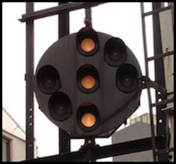
Repeater Signal showing “Proceed” (2006)
Odakyu Electric Railway, Yoyogihachiman Station
Photographer: PON2600
A repeater signal, also called a “relay signal”, will be marked with a block sign (orange triangle) bearing the kanji “中” (“medium”).
Per the MLIT document, “lights of position light signals shall be white or of a color that may not be mistaken for other color light systems”, which would appear to rule out the use of color-position signals, Color-position signals are used for shunting signals (see photo above for Starting Signal), but that’s a different kind of signal.
In underground applications the circular head is impractical, and a repeater signal is distinguished by having an additional light of purple color that is constantly lit (the one example I have seen of this had purple as the lowest light on the signal).
Shunting Signals
A shunting signal (入換信号機, irekae shingōki) is a signal capable of displaying Stop, Caution and Proceed (or subsets), used to control trains or locomotives performing moves other than normal train operation, within the bounds of stations, depots and yards. Shunting signals are interlocked signals, and depend on the state of both track detection circuits and the positions of switches (i.e., they will not provide a non-Stop indication if a track is occupied or points are set against a movement). A shunting signal may be marked with a sign reading “入換” (Irekai).
Shunting signals can also be used as “route clear” signals in some (unclear) circumstances. This may be used to allow trains to move within a station if the normal signal has failed.
Shunting signals on JR are usually small position light signals. However the MLIT standards also allow for color-light signals, and these are apparently used by some third-party (non-JR) railroads (see photo above for Starting Signal). Although these are small signals, they are often mounted on shared masts (below main signals) or even at eye level on their own mast. They may also be mounted to overhead structures.
Shunting signals authorize a maximum speed of 45 kph, and this is limited to 25 kph when passing a non-locked switch in the facing-point direction. Shunting can also be controlled via hand signals or through remote (radio) control by a driver in the position of the person who would otherwise give hand signals, but this is also limited to 25 kph operation.
Shunting can also be authorized by call-on signals, signs, and manual shunting via hand signals is allowed under some circumstances. And there appears to be some provision for shunting of Shinkansen under ATC (automatic train control, the automatic stop system associated with cab signals).
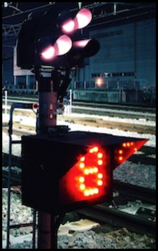
Shunting Signal at Caution with Route Indicator (JR Freight, Fukuoka, 2011)
Photographer: Tsuna72
Wayside Signals
Wayside signals (Japanese name unclear) serve a role very similar to Shunting signals, but are for Shinkansen and maglev lines (which normally use cab signals) and they can also be used to control entry to a station during a cab-signal failure. The rules affecting them and the aspects they can display are generally identical to those of shunting signals, except that they will not be located below another signal (as there is no other signal).
I’ve seen several Shinkansen signals that are a single color-light (usually green) on a mast above a position-light shunting signal. That’s not a form allowed for a Wayside signal per the MLIT document. It’s also not a form allowed for a call-on signal (which has to be yellow if it appears alone). I don’t think those are wayside signals, but it’s possible that this is some variant form using a multi-color “searchlight” type signal (I’m not aware of those being used in Japan though).
Note: shunting signals can also be used as “route clear” signals, so the distinction above about station entry may not really be a distinction.
The speed limit imposed by a Wayside signal is 45 kph.
Temporary Signals
A temporary signal is used to define a limited-duration speed restriction. There is a requirement that the “speed should be indicated” along with these, but the MLIT document doesn’t say how (use of signs is likely). Wikipedia shows these as fixed signs with associated two-digit numbers where needed to indicate the speed. However, I’ve also seen temporary signal masts in photos which may be another form.
There are three types of these:
Low-Speed Signal / Speed Restriction (徐行信号機, jokō shingōki)
This marks the start of the speed restriction.
Low-Speed Notification Signal / Speed Restriction Warning (徐行予告信号機, jokō yokoku shingōki)
This provides advance notice up an upcoming Low-Speed Signal.
Speed Limit Termination Indicator / Speed Restriction Termination (徐行解除信号機, jokō kaijo shingōki)
This marks the end of the temporary speed restriction.
Other Signals
Call-On
A Call-on Signal (誘導信号機, yūdō shingōki) is an Amber (or Yellow, the terms seems to be used interchangeably in English translations) signal mounted a minimum of 60 cm below or below and offset to the right, from the signal it modifies (normal or shunting) that authorizes a train to operate beyond the position of the signal, but not to pass the next signal. A call-on signal is the lowest signal on a mast, and will be below any main or shunting signals and any signal appendix.
I have seen images of signals that appear to be call-on signals except for being lunar white rather than yellow, although those could be a color error in the photographs (see starting signal illustration above).
Per the MLIT document this can also be a two-lamp position light signal with a 45-degree lower-left aspect using white lights or “a color that may not be mistaken for signals of other color-light signals” (note that a shunting signal uses upper-right for caution, so this is potentially confusing).
The speed limit imposed by a call-on signal is 25 kph.
Occupation Signal
Siding occupation signals (Japanese name not known) are small white signals, which may be found on the mast of the signal controlling exit from the siding, or attached to part of the platform structure, or just on a post by itself. When a train is entering the siding the signal will flash, and then become lit solid when the train is fully within the siding (indicating that the rear is clear of the switch). The signal is unlit when the siding is empty. Note: I haven’t found any documentation of this except for one hobbyist site (which did include a few prototype photos which appeared to confirm the description).
Signal Appendix
A signal appendix (信号付属機, shingō fuzokuki) isn’t a signal in its own right, but a marker light or other element attached to a signal that modifies or clarifies its meaning. According to the MLIT document, there are two types of this, the route indicator and the preliminary route indicator.
Route Indicator
A route indicator (進路表示機, shinro hyōjiki) is associated with a Home, Starting, wayside, call-on, or shunting signal when there are two or more branches possible in the track section protected by the signal. In practice, this doesn’t seem to always be used, and instead sometimes each route gets its own signal. There may be a fine level of distinction between the two cases, but one isn’t clear from my readings. It may simply be that route indicators are used where it isn’t practical, or necessary, to fit an entire subordinate head for each route. For example, the Chūō line allows “wrong track” running in some locations. Crossovers in the “normal” direction have a subordinate head for crossing trains, but in the reverse direction a single head with route indicators is used.
I have seen images of these using arrows or dot-matrix numbers, but the MLIT document doesn’t appear to specify any form, so these may be railroad-specific.
Note that these aren’t used with Block signals.
For one example of a numeric route indicator, see the shunting signal example above. One other form is displayed below, but I’ve also seen ones with two larger lunar lights, one close to the mast for the through route and one offset further and on the other side of the mast for the diverging route.
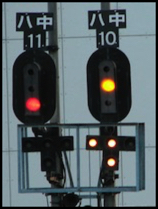
Starting Signals for two tracks with route indicators at Sapporo, track 10 signaled for left diverging route (2005)
Photographer: Ncsa3809
Preliminary Route Indicator
A preliminary route indicator (進路予告機, shinro yokokuki) is associated with a Main (block, home, or starting), Distant or Repeating signal, providing advance notice about the route to be taken at the next Home or Starting signal.
Wikipedia also lists couple of additional types I haven’t found other information on:
Rail Indicator
Wikipedia only notes that the Rail Indicator (線路表示器, senro hyōjiki) is a position light signal attached to a shunting sign (not a shunting signal). The word “rail” here also translates as “line”, so this is probably a specialized form of route indicator used when shunting signs, rather than shunting signals, are in use.
The MLIT document makes a passing reference to shunting being possible via “indicators” as a third option (to signals and fixed signs).
Train Type Sign / Train Type Indicator
A Train Type Indicator (列車種別表示灯, ressha shubetsu hyōjitō) is an electronic sign displaying the type of train that can pass a signal, using alphanumerics or symbols. This is apparently used by third-party railways.
Signal Lamp Size and Spacing
The requirements for signal lamp size and spacing are set out in the Approved Model Specifications, VII-2, Article 55, specifically sections (1)(1), (1)(2) and (1)(11). I’ve summarized these requirements below. All spacings are to be measured center-to-center. All lamps are located against backing boards painted black.
- Lamps on color-lamp signals (including shunting and passing signals) are required to be at least 100mm in diameter and spaced at least 200mm apart. In tunnels spacing may be reduced to 180mm.
- According to Japanese Wikipedia, LED bulbs are now in use and have diameters of 150mm.
- Position-light signals used for repeaters in tunnels may use lamps as small as 40mm with spacing not less than 150mm.
- Lamps on position-light signals must be at least 90mm in diameter, and spacing for lamps must be at least 250mm.
- Call on signals (which may be a single Yellow lamp or two Lunar position-light lamps) must be spaced at least 600mm below the lowest light of a Home signal.
- Shunting signals (which may be color-posiiton or position-light signals) must be spaced at least 250mm below a call-on signal.
- Passing signals (color-light signals) must be at least 800mm below the lowest lamp of a Home signal.
- When two lamps on the same color-light signal head are lit, additional spacing rules apply, see the Signal Aspects page.
(per the MLIT document, Approved Model Specifications, VII-2 Art. 55 (1)(1)). There are exceptions for signals in tunnels and different rules for position-light signals, see the Signal Types page for additional details. When two lights on the same head are lit, they must be at least 600mm apart (center to center), which means that two dark lights must be between them (Art. 55 (1)(11)).
All spacings represent center-to-center distance of the lenses, regardless of lens diameter. Other signals must be a minimum of 90 mm in diameter and be at least 600 mm from a home, start or block lens (passing signal lamps must be a minimum of 800 mm below the lowest home signal lamp). Call-on signal lights must be a minimum of 250 mm from shunting signals if both exist. Finally, lights used in position-light signals (this includes shunting signals) must be at least 250 mm apart, 150 mm in tunnels.




